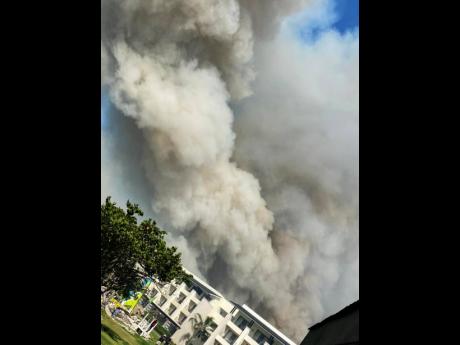Negril morass fire leaves bitter taste as UN rehab stalls
WESTERN BUREAU: Last Friday’s Negril Great Morass fire, which caused jitters among several tourists vacationing in the Long Bay area, is being blamed on the delay in implementation of a US$3.1-million grant from the United Nations Environment...
WESTERN BUREAU:
Last Friday’s Negril Great Morass fire, which caused jitters among several tourists vacationing in the Long Bay area, is being blamed on the delay in implementation of a US$3.1-million grant from the United Nations Environment Programme (UNEP).
It has been four years since the money was granted under the IWEco (Integrated Water, Land and Ecosystems Management in Caribbean Small Island Developing States) programme. However, sources say much of the funds have been expended though core elements of the actual project have not been touched.
The funds were gifted in 2018, with the National Environment and Planning Agency (NEPA) overseeing its implementation. A project manager was named, Loureene Jones, but when The Gleaner contacted her on Sunday, she said she was no longer involved.
In the meantime, the Negril Great Morass, the second-largest wetland in Jamaica and one of the largest natural coastal wetland ecosystems in the Caribbean, continues to endure sporadic fires.
Last Friday was extremely frightening, said a hotelier who asked not to be named, and at least one major resort was forced to lock all their guests inside.
Chairman of the IWEco project steering committee, Richard Wallace, said he was unaware of the cause of the fire, but confirmed that it created panic along sections of the beach near Bloody Bay.
He said Hedonism II complained, all the way down to the Board Walk, which is his property, and the Azul Resort was covered in smoke. According to Wallace, visitors in tour buses at the Boardwalk literally started panicking.
“They wanted to leave right away. They thought the fire was coming. The fire actually came close to the road,” Wallace said in a Gleaner interview Sunday, which was recognised as World Environment Day.
“It was visible from the road and the tourists saw the fire. They wanted to leave right away, and so they actually left even though we reassured them that it wouldn’t be coming across.”
Concerns grew as the atmosphere was darkened with smoke, with guests requesting to be relocated to safer ground for fear that their children with a history of respiratory illness could suffer from complications. Wallace said the fire lasted for a few hours.
The steering committee chairman said that the project, aimed at rewetting the morass, has been in train for three years.
“This is concerning for all of us, including the funding agency, UNEP. They are very concerned that three years and after millions of US dollars spent, we have not gotten to the point where the actual work in the morass, the blocking of the canals, can begin to raise the water level to rectify the problems that we’re having in the environment here in Negril,” Wallace said.
Factors behind the draining of the morass date back to the 1950s when the area was being developed, he said.
Wallace is urging NEPA officials to get going with the project.
He cautioned that another fire might be more detrimental.
“We hope that next time it won’t get worse and start affecting buildings along the boulevard,” Wallace added.
UNEP’s regional project coordinator, Jan Betlem, referred The Gleaner to NEPA. Calls to that organisation’s chief executive officer, Peter Knight, went unanswered.
Efforts seeking comment from Matthew Samuda, Jamaica’s de facto environment minister, were also unsuccessful as calls went to voicemail.


